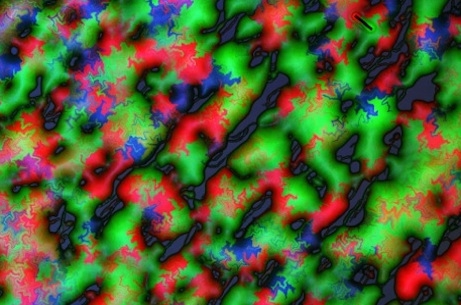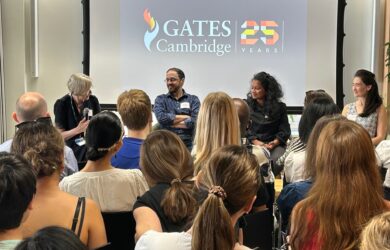
A new study on the fractal patterns in bacterial cells could have important implications for synthetic biology.
Despite bacterial colonies always forming circular shapes as they grow, their cells form internal divisions which are highly asymmetrical and branched. These fractal (self-similar) patterns are due to the physical forces and local instabilities that are a natural part of bacterial cell growth, a new study reveals.
The research, published in the scientific journal ACS Synthetic Biology and co-authored by Gates Cambridge Alumnus Fernan Federici [2005], has important implications for the emerging field of synthetic biology.
Using a combination of genetic, microscopy and computational tools, Cambridge scientists created a system for examining the development of multicellular bacterial populations. After marking bacteria by inserting genes for different coloured proteins, the researchers used high resolution microscopes to examine the growth of bacterial populations in detail. They discovered that as bacteria grow the cell populations naturally form striking and unexpected branching patterns called fractals. The scientists then used large-scale computer models to explore the patterning process.
They showed that as each bacterium grows in a single direction, lines or files of cells are formed, but these files are unstable to small disturbances. As large numbers of cells push and shove against each other, mechanical instability leads to buckling and folding of cell files. This is repeated as the cells continue to grow and divide, leading to the formation of rafts of aligned cells arranged in self-similar branching patterns, or fractals.
These microscopic fractal patterns emerge spontaneously from physical interactions between the large number of cells within the population. This was tested by looking at the interactions between twin cell populations and a mutant bacterium that has a round shape (where this behaviour is not observed).
Dr Jim Haseloff, from the Department of Plant Sciences at the University of Cambridge and lead author of the study, said: “Vivid biological patterns emerge from even subtle interactions. Similar phenomena are seen in the emergence of order in economic, social and political systems.
“The behaviour of large populations can be hard to predict, but the work has resulted in the validation of fast and accurate computer models that provide a test bed for reprogramming of multicellular systems.”
Synthetic Biology is a new field that brings engineering principles to biology to reprogram living systems using DNA. It is has the potential to create a new generation of sustainable technologies, with the prospect of new forms of materials and energy produced by biological feedstocks and recycling of waste. As synthetic biologists are starting to reprogram the behaviour of large populations of cells in order to explore new forms of self-organisation and function, this study will have important implications for their research.
Dr Haseloff added: “This is an experimental system that can capture the physics, cellularity and genetics of growth in a simple system – and which allows a new type of ‘emergence in a test-tube’ approach.
“Also, it provides a new insight into the way cell populations may interact during the early formation of medically important bacterial populations or biofilms, and produce irregular boundaries for invasive growth and increased surface contact. This could have important implications for understanding the formation of these biofilms, and for engineering new biofilms in biotechnology.”
Fernan, whose PhD in Plant Sciences focused on the development of computational-genetic tools for the automotion of cell growth and gene activity analysis, said the development of tools such as CellModeller, which was central to this research, was critical for future developments in synthetic biology. CellModeller captures the mechanical and genetic interactions in large populations of cells which give rise to self-organising processes which are otherwise hard to predict and understand.
He said: “Engineering multicellular systems has been identified as the next step for synthetic biology, and there is an increasing need for tools like CellModeller for the exploration of different designs in silico, and the reliable prediction of their behaviour before construction. We are now combining these tools with libraries of characterised genetic elements seeking to establish a pipeline for bioengineering where we measure the performance of small genetic modules, feed this information into mathematical models and computational tools that explore combinatorially the engineering of larger genetic circuits, and finally we synthesise/assemble the ones with a desirable biological functions. This will facilitate automated design and evolutionary/optimisation routines to be also used.”












